#Prakṛti
Text
Book of the Day - Yoga Sutras of Patanjali
Today’s Book of the Day is Yoga Sutras, written by Patanjali around the 2nd century BCE.
Patanjali – पतञ्जलि, also called Gonardiya or Gonikaputra, was a Hindu author, mystic, and philosopher, who was believed to be a Siddhar, an enlightened scholar of Yoga and spiritual knowledge. He lived between the 2nd and 4th centuries CE.
I have chosen this book because people often ask me which kind of…

View On WordPress
#Asana#Ashtanga#Ashtanga Yoga#Dharana#Dhyana#Eight Limbs#Kaivalya#meditation#Niyama#Patanjali#Patanjali&039;s Ashtanga Yoga#Prakṛti#Pranayama#Purusha#Raffaello Palandri#Raffaello Palandri Yoga#Samadhi#Tantra#Yama#Yoga#Yoga Sutra
33 notes
·
View notes
Text
Joseph Campbell, THE MYSTERY NUMBER OF THE GODDESS

The Indian (Sānkhya) philosophers recognized as arising three “qualities or characteristics” (guṇas), through the interrelation of which all of “nature” (prakṛti) was seen as motivated; namely, “inertia, mass, or heaviness” (tamas); “energy and vitality” (rajas); and the “harmony or clarity” (sattva) of any balanced relationship of the opposed two. In Pythagorean terms, the same three would correspond, respectively, to (1) the “unlimited,” (2) the “limiting,” and (3) the “harmony” or “fitting together” (harmonia) of any “beautiful order of things” (kosmos), whether as a macrocosm (the universe), microcosm (an individual), or mesocosm (ideal society or work of art). And the number representative in that system of such a visible order is 4.

The Pythagorean tetraktys, viewed as an upward-pointing triangle built of 9 points with a tenth, as bindu, in the center, suggests an Indian tantric diagram (yantra) symbolic of the female power in its spiritually alluring role recognized by Goethe in the last two lines of his Faust: “Das Ewig-Weibliche/Zieht uns hinan!”

The trinity here is not of three male divinities with the Virgin then as a feminine fourth but of the classical three Graces with Apollo as a masculine fourth. Both the names and the postures of the Graces tell of the qualities of their influence: (1) Thalia (“Blooming, Abundance”) unites and relates her opposed companions; (2) Euphrosyne (“Mirth, Festivity, Good Cheer”) moves away from the God to the descent, ninefold, of the Muses; while (3) Aglaia (“Splendor, Beauty, Triumph, Adornment”) confronts him, returning to source. Pico and Ficino revered these three as an exemplary triad archetypal of all the others of classical myth. In Pico’s words, “He that understands profoundly and clearly how the unity of Venus is unfolded in the trinity of the Graces, and the unity of Necessity in the trinity of the Fates, and the unity of Saturn in the trinity of Jupiter, Neptune, and Pluto, knows the proper way of proceeding in Orphic theology.” For as Edgar Wind points out in commenting on this passage, “it was an axiom of Platonic theology that every god exerts his power in a traidic rhythm.”
#legend of zelda#zelda#twilight princess#goddesses#group of three#farore#nayru#pythagoras#gunas#neoplatonism#marsilio ficino#muses#nine muses#three graces#greek mythology#greek gods#apollo#joseph campbell#great goddess#hinduism#cosmos#harmony#sattva#goddess hylia#hylia#hylian
2 notes
·
View notes
Text
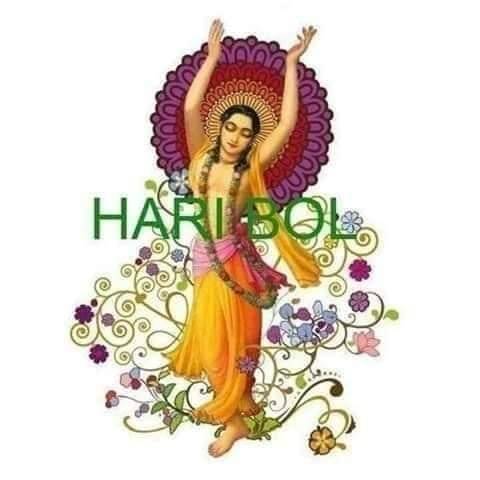
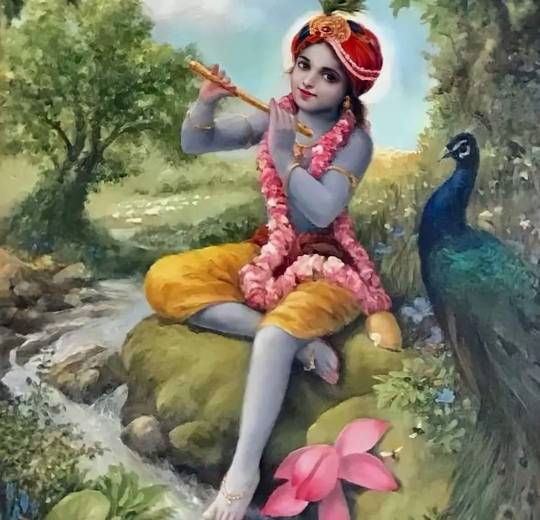
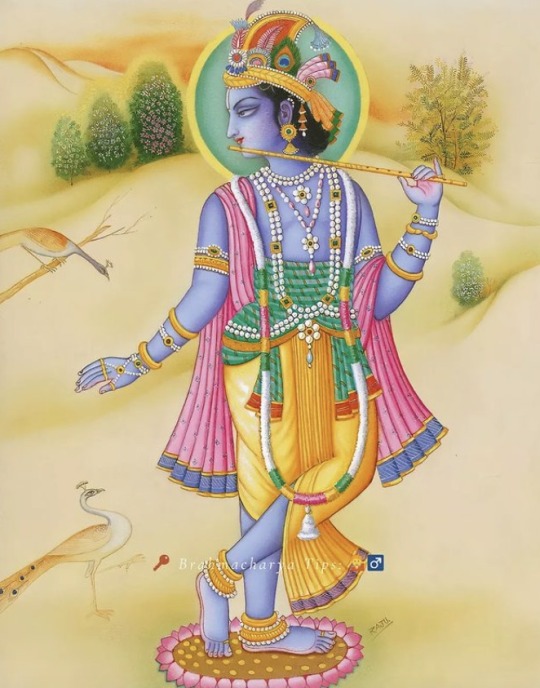
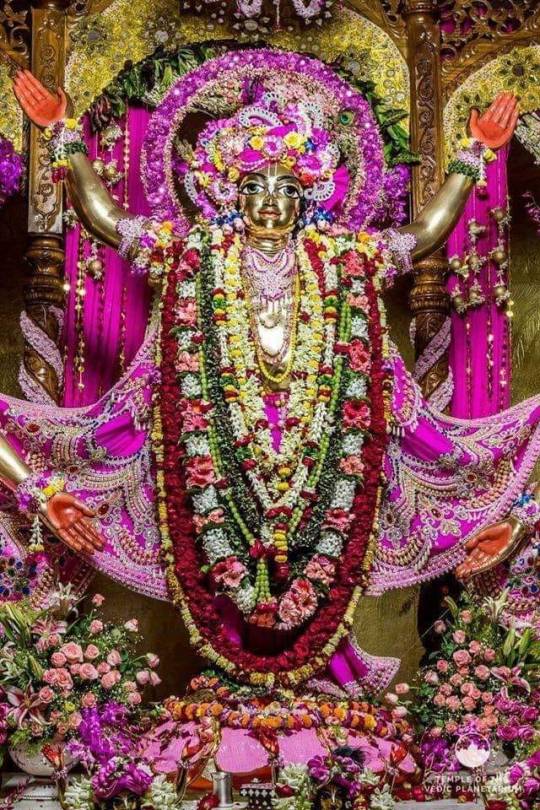
The word mantra means “that which delivers one from the material world.”
Only the dvijas (the brāhmaṇas) and the devas (the demigods) can be delivered from material existence by the instructions of the Supreme Personality of Godhead.
Whatever is spoken by the Supreme Personality of Godhead is a mantra and is suitable for delivering the conditioned souls from mental speculation.
The conditioned souls are engaged in a struggle for existence (manaḥ ṣaṣṭhānīndriyāṇi prakṛti-sthāni karṣati).
Deliverance from this struggle constitutes the highest benefit, but unless one gets a mantra from the Supreme Personality of Godhead, deliverance is impossible.
2 notes
·
View notes
Text
About Mahabhuta, the Apricity Interlude
Despite sharing excerpts, I never explained the fic, so here I am!
[Also, tagging because you might be interested: @mrsmungus, @udaberriwrites, @magma-saarebas19, @danceswithdarkspawn, @aislinnstanaka, @writingpotato07, @alpaca-clouds]
Mahabhuta & Interlude Objectives
As mentioned, Mahabhuta is an interlude (likely the first of many) to Apricity. It takes place in the week between the La Push Bonfire (Obsidian, Ch 10) and the Seattle Day Trip (starting in Sapphire, Ch 12). The chapter in between, (Azure, Ch 11) takes place over the course of this week, but it only covers a few things.
In general, the Saturday that the La Push bonfire happens is a major turning point. The change doesn't just reflect Beau's mind (through the dreams) - they also represent other changes in that world, as well as the mystic bond. This will show up within Mahabhuta and Apricity.
Overview of the Interlude Structure
Mahabhuta is structured in a 5+1 format, for six chapters in total.
Mahabhuta is Sanskrit for "great element". The first five chapters are the five classical elements and the +1 chapter is the original element. Each of those five classical elements has an associated color, sense, and body part. In addition, I used vampire bingo prompts, to assign one main prompt and two secondary prompts to the dreams. Lastly, I've associated each of the Cullen siblings with each element.
All six chapters have a dream phase with Beau and a reality phase with Mike. The elemental themes are in both phases. The dream is E-rated for smut and the reality phase is T-rated. Both are plot-crucial.
The Classic Elements in Sanskrit
As you might have noticed, the titles are in Sanskrit, reflecting the Eastern themes of the WL verse. These are the elements in their traditional order (from coarse to fine, the ground to the heavens):
Prithvi (पृथ्वी, pṛthvī) - Earth
Varuna (वरुण, váruṇa) - Water
Agni (अग्नि, agni) - Fire
Vayu (वायु, vāyu) - Air, Wind
Akasha (आकाश, ākāśa) - Sky, Void, Space
Prakriti (प्रकृति, prakṛti) - Prime, The Origin
Interlude Specifics - Names, Days, Prompts, and Concepts
(as a side note, the Obsidian bonfire was Saturday evening, with the Azure dream taking place over Saturday night into Sunday morning)
Prithvi [Earth]
POV: Beau (dream) + Mike (reality)
Timeline: Sunday night - Monday evening
Color: Green
Sense: Smell/Scent
Body: Flesh/Bone
Vampire: Alice
Prompts: Altar Sex, Fangs, Vampire Bites
Varuna [Water]
POV: Beau (dream) + Mike (reality)
Timeline: Monday night - Tuesday evening
Color: Blue
Sense: Taste
Body: Blood
Vampire: Mina
Prompts: Mist, Blood Sharing, Rejuvenation
Agni [Fire]
POV: Beau (dream) + Mike (reality)
Timeline: Tuesday night - Wednesday evening
Color: Red
Sense: Sight/Vision
Body: Body Heat
Vampire: Elle
Prompts: Fever, Long/Never-Ending Night, Feeling the Cold
Vayu [Air]
POV: Beau (dream) + Mike (reality)
Timeline: Wednesday night - Thursday evening
Color: Yellow
Sense: Touch
Body: Breath
Vampire: Rosalie
Prompts: Hunting, Shadows, Heartbeats
Akasha [Sky]
POV: Beau (dream) + Mike (reality)
Timeline: Thursday night - Friday evening
Color: Violet
Sense: Sound
Body: Soul, Spirit
Vampire: Edward
Prompts: Moonlight, Ageless, Ethereal Beauty
Prakriti [Prime]
POV: Carlisle (dream) + Carlisle (reality)
Timeline: Friday night - Saturday evening***
(***this Saturday is the Seattle trip, coincides with Sapphire onwards)
Color: Black, White
Sense: All
Body: All
Vampire: Carlisle
Prompts: Telepathic Connection, Feral, Humanity
In Conclusion...
This was a fun concept to come up with, and as always, I have to thank Alhaira for being a sound board and listening to my rambles. And yes, some of the stuff that happens will be referenced in Apricity before the corresponding Mahabhuta chapter is posted on AO3.
While it'll be possible to read these chapters fandom-blind (since... you know, the Winter Light verse and Apricity are fandom-blind friendly by default), you would be best off reading Apricity first.
I recommend reading through Azure (Ch 11) for the five elemental chapters and through Midnight (Ch 14) for the +1 chapter, Prakriti.
Not that there's any rush - I'm only halfway through Prithvi (as of January 25)! It's not like Mahabhuta is the only thing I'm working on either - I'll be moving through Apricity and other short pieces. And as everyone and their friend knows... I'm not exactly the fastest writer!
(thank goodness, because Prakriti is already low-key scaring me O.O)
Though... considering I'm at 10k words and see Prithvi hitting 15-20k words in the end, I am considering splitting it. I'll have to see in the end how that turns out. But that is all from me... for now~
#twilight#carlisle x beau#bellisle#mahabhuta#winter light#carlisle x bella#bella x carlisle#twilight renaissance#gay twilight#apricity#mizuka explains#mizuka's rambles#twilight rewrite
13 notes
·
View notes
Text
What is male ego?
Male ego means the desire to gratify or enjoy sense objects. In Sastras, it is technically called Purusha Abhimana (falsely thinking, ‘’I am the doer, I am the enjoyer’’). The word Purusha is a technical term and applies to all the material genders of this material world, whether so-called male, female or any other. This enjoying mentality is the root cause of our material bondage in this world (samsara), causing us to suffer in the repeated cycle of birth and death.
In the words of Srila Prabhupada
The living entities, in the guises of men and women, are trying to enjoy the material energy; therefore in one sense everyone is puruṣa because puruṣa means "enjoyer" and prakṛti means "enjoyed." In this material world, both the so-called man and so-called woman are imitating the real puruṣa; the Supreme Personality of Godhead (Lord Krishna) is actually the enjoyer in the transcendental sense, whereas all others are prakṛti (enjoyed)
-Purport to Śrīmad-Bhāgavatam 3.25.11
As long as we think, ‘’we are the enjoyers of everything we survey’’, we will suffer, for nothing belongs to us. Everything, including our own body, belongs to Krishna. Everything is His property (īśāvāsyam idaḿ sarvaṁ- Iso Upanishad- Mantra 1). When we factually understand that Krishna is the only supreme enjoyer and the supreme object of our love, then we attain real peace and eternal bliss. Then, Maya (material illusion) will no more trouble us.
ahaṁ hi sarva-yajñānāṁ bhoktā ca prabhur eva ca
[Lord Krishna says] I am the only enjoyer and master of all the offerings- Bhagavad Gita 9.24
A hand has no value if it is cut off from the body, for it cannot enjoy food independently, for such is the constitution of the hand in relation to the body. Similarly, a living entity, being an eternal part and parcel of the Lord, can only find happiness by experiencing the happiness of Krishna. If it tries to enjoy independently for its personal sense-gratification, it will become cut off from its spiritual essence, like a fish struggling outside water, and will thus suffer material bondage. This is the constitutional identity of a living entity in relation to Krishna. This is the intrinsic and unchanging dharma of the individual soul, just as the dharma of sugar is sweetness.
If however, some fortunate soul, by the practice of Bhakti yoga, attains pure love for Krishna and hears the enchanting flute song of Krishna, then all his so-called male ego (Purusha abhimana) will flee in shame.
samsare asiya,prakrti bhajiya, purusabhimane mari
krsna doya kori',nije abatari', bamsi-rabe nila hari'
I have come into this false material existence, adoring the material energy, thinking it fit for my enjoyment, and, now, I am seized with the false conception that I am a male (a purusa). But Lord Krsna, showing His compassion, descends Himself and forcibly steals away all such false conceptions with the transcendental sound of His flute.- Kalyana Kalpataru book, Bahirmukha Ho’ye Mayare Bhajiye
#krsna#hare krsna#iskon#iskontemple#krishna#hare krishna#harekrishna#lord krishna#lordkrishna#lordshiva#lordvishnu#lordram#bhagavatam#srimadbhagavatam#mahabharata#shrimadbhagwatgeeta#bhagvadgita#bhagwan shiv#bhagwad gita#bhagwatgeeta#bhagwan#geetagyan#bhagavadgita#gitavali#bhagwatgita#gita
3 notes
·
View notes
Text
Preceding with Sakti
The philosophical underpinnings of Sakti, the All-pervading Energy.
NOTHING can exist unless there is some ground for its existence, some substratum from which it may rise. There must also be some possibility and some reason for existence. We have seen that the universal substatum was called the Immensity (brahman) and that the mechanical potentiality of manifestation lay in the form of opposing tendencies represented as cohesion (Vişnu) and disintegration (Śiva), their balance, the space-time creating principle, being known as the Immense-Being (Brahmā).
The tension between the opposites from which motion arises in the substratum is depicted as the first appearance of energy (sakti). It is from manifest energy, and not merely from the opposition from which it springs forth, that existence arises. Energy does not pertain to one or the other of the opposites nor to their opposition. It is something more, something new. Once manifestation has taken place, it appears as the substance of everything, pervading every thing. It can be represented as the power of Siva or that of Visnu or that of Brahma. As the power of their combined form, Isvara, it becomes the Supreme Goddess (Bhagavati), the Resplendent-One (Devi). It can even be conceived as the power which appears in the neutral Immensity, as the maelstrom from which existence and the three basic-tendencies (gunas) themselves appear to arise; it is then called Illusion (Maya). From the point of view of cosmology this power, when manifest, it is called Nature (prakṛti). It is through it that the gods are born and procreate, Energy is pictured as female, being the creative birth giving aspect of divinity, the power through which creation manifests. It is only when the qualityless, shapeless, substratum becomes: "The quality of being divine, appearing in that in which there is most energy." powerful beings, rest upon that of power. The gods are infused through and through by the great Energy. A limitless center from which the universe can be created, maintained, and destroyed. Without energy, Siva, the lord of sleep, is unable to create or destroy, He is as powerless as a corpse. The divinity of divinity rests upon Energy. "She is the power of the Self; she it is who creates appearances." In the Linga-arcana Tantra we read: "Devoid of senses, the eternal lord of sleep is merely the form of the Void. He has no visible form. What can be expected from the worship of nothingness?
"Without the great Daughter-of-the-Mountain (Parvati), ever glorified as his supreme dread energy, the corpse of Rudra is never worshiped. This primordial goddess is known as "the coiled, Kundalini". Her substance is Brahma-Vişnu-Šiva. She envelops Šiva with her three and a half veils. Only because he is united with Energy is the eternal lord of sleep a doer of actions. This is why the Goddess is worshiped as a linga surrounded by a yoni." "The quiescent aspect of Siva is, by definition, inert. Activity is the nature of Nature (prakṛti). For this reason the female form is represented in sexual union as being above (vipartta) the male. When the devi is shown standing above Siva... [this also represents] the liberating aspect of the Mother." (Woodroffe, The Serpent Power, p. 27)
Among the Saktas, who are the worshipers of the Goddess, the source of existence is considered female, becomes the main representation of divinity is God as woman.
Yet power is ever inseparable from him who possesses it. So the all-powerful Energy cannot be really distinct from the substratum from which it arises. The concept of Sakti is necessary to justify the appearance of the perceptible universe out of an inaccessible, motionless substratum.
The word Sakti, meaning "energy," is found in the Vedas, where its equivalent is in fact (divine grace), representing Energy, personified as the consort of Indra, the divine might. The notion of Sakti as the supreme power seems to appear fully only in the Svetasvatara Upanisad, one of the Saivite Upanisads.
In the common Hindu theology, Sakti is but another name for the manifesting power, the creative principle. It takes the place of Brahma, the Cosmic Embryo (Hiranya-garbha). In later mythology the concept of Sakti comes to include both the notions of a concentrating and illuminating the power that is Vişņu and an active space-time principle that is Brahma to form the complement of the male, positive, ultimate knowledge that is Śiva.
Descending from the earliest prehistoric Saivism, the eternal couple Šiva and the all-pervading Energy Sakti is represented in the male and the female emblems, the linga and the yoni, pervades the whole of later Hinduism. The linga embraced by the yoni forms the central object of worship and tends to reduce to a minor position all the other ways of representing divinity.
Energy is the source of everything, the origin of the phenomenal world but also of the conscious plan of its creation, and the principle of knowledge or perception through which its existence, real or apparent, can be known. Thus the Goddess is also represented as Consciousness or as Knowledge. Without her the gods are dead, inactive, unknown, nonexistent. Knowledge (jana) without action (kriya) is dead knowledge, and so is feeling (rasa) without strength (bala).
The Goddess is the source of all, the universal creator. "The gods, approaching the resplendent Goddess, asked her, 'Who are you?' The Goddess replied, 'I am the form of the Immensity; from me the world arises as Nature and Person (prakṛti-purusa)." (Devi Upanisad 1-2 [478])
"She is the form of all that is conscious. The origin, the knowledge, the perception of reality, the instigator of intellect." (Devi Bhagavata Purāņa 1.1. [479])
She is realized in the microcosm as the ultimate goal of Yoga.
"In the principial-aperture (the brahma-randhra, behind the forehead) each man finds me, the lady-of-the-spheres (Bhuvaneśvari), who am the shape of the Principle, beyond the Fourth [unmanifest] stage." (Bhuvanesvart Upanisad. [480])
The Devi Sukta of the Rg Veda describes her as supreme, all-pervading divinity.
The Goddess says:
"I wander with the principles-of-life (Rudras), with the spheres-of-existence (Vasus), the sovereign-principles (Adityas), and the all-pervading-gods (Viśvadevas). I am the support of Might (Indra), of Fire (Agni), of the law-of Asvins). I am the support of the soma wine which flows from the crushing man-and-gods (Mitra-Varuna), of the horse-headed gods-of-agriculture (the stone; I am the support of the Shaper (Tvaştr), of the Nourisher (Paşan), of the Inherited-Share (Bhaga). I am the giver of the fruit of action to the performer of the ritual sacrifice, which nourishes the gods with offerings. "I am the Kingdom, the giver of wealth, the knower of the essence of things. I come first in all rituals. The gods have established me in various abodes. My sphere is wide. I dwell in all things.
"From me comes the food you eat, all that you see, all that has breath (prāna), and all the words you hear. Those who do not acknowledge me are destroyed. Study and hear what I say with respect. I am the pleasure of gods and men".
"I make everyone whatever he wishes to be, feared or great, a man of vision or intellect. I draw the bow of the lord-of-tears (Rudra) to kill the tribes of the enemies of knowledge. I fight for the people. I enter the sky and the earth. I give birth to the father and I am his head. I spring forth from the waters of the ocean. From there I spread into the universe. I touch the sky with my body. I blow like the wind, creating the worlds. My greatness expands beyond the sky and the earth." (Rg Veda 10.125.1-8. [481])
As the source, the plan of the universe, Energy first appears as a consciousness. Knowledge, that is, the perception of the existing universe, is its manifest form. There is a conscious plan for everything and therefore a possibility of knowing, a knowledge related to everything. The knowledge of the universe is the transcendent-knowledge (maha-vidya), whose form is identical to that of the all-powerful Goddess, and fragments of which are expressed in the revealed scripture, the Veda.
The knowledge of the cosmos is called virat-vidya; that of the manifest universe is visva-vidya. The main aspects of existence as perceived from the point of view of man are represented in the ten forms of the Goddess, the ten objects-of-transcendent-knowledge (maha-vidyā, महाविद्या) which are her most commonly worshiped aspects. Mahavidyas are usually named in the following sequence: Kali, Tara, Tripura Sundari, Bhuvaneshvari, Bhairavi , ChhinNamasta, Dhumavati, Bagalamukhi, Matangi and Kamala. Nevertheless the formation of this group encompass divergent and varied religious traditions that include yogini worship, Saivism, Vaishnavism, and Vajrayana Buddhism.

7 notes
·
View notes
Photo

महात्मानस्तु मां पार्थ दैवीं प्रकृतिमाश्रिताः | भजन्त्यनन्यमनसो ज्ञात्वा भूतादिमव्ययम् || १३ || mahātmānas tu māṁ pārtha daivīṁ prakṛtim āśritāḥ bhajanty ananya-manaso jñātvā bhūtādim avyayam O son of Pṛthā, those who are not deluded, the great souls, are under the protection of the divine nature. They are fully engaged in devotional service because they know Me as the Supreme Personality of Godhead, original and inexhaustible. In this verse the description of the mahātmā is clearly given. The first sign of the mahātmā is that he is already situated in the divine nature. He is not under the control of material nature. And how is this effected? That is explained in the Seventh Chapter: one who surrenders unto the Supreme Personality of Godhead, Śrī Kṛṣṇa, at once becomes freed from the control of material nature. That is the qualification. One can become free from the control of material nature as soon as he surrenders his soul to the Supreme Personality of Godhead. That is the preliminary formula. Being marginal potency, as soon as the living entity is freed from the control of material nature, he is put under the guidance of the spiritual nature. The guidance of the spiritual nature is called daivī prakṛti, divine nature. So when one is promoted in that way – by surrendering to the Supreme Personality of Godhead – one attains to the stage of great soul, mahātmā. https://gloriousgita.com/verse/en/9/13 https://vedabase.io/en/library/bg/9/13/ https://bhagavad-gita.org/Gita/verse-09-13.html https://bookchanges.com/wp-content/uploads/2009/09/Bg-Chapter-9-diff.htm https://youtube.com/c/HearSrilaPrabhupada https://www.bhagavad-gita.us/famous-reflections-on-the-bhagavad-gita/ #bhagavatam #srimadbhagavatam #vishnu #vishnupuran #harekrishna #harekrsna #harekrishna #harekrisna #prabhupada #bhagavadgita #bhagavadgitaasitis #bhagavadgītā #srilaprabhupada #srilaprabhupad #srilaprabhupadaquotes #asitis #india #indian #wayoflife #religion #goals #goaloflife #spiritual #bhakti #bhaktiyoga #chant #prasadam #picoftheday #photo #beautiful #usa https://sites.google.com/view/sanatan-dharma https://m.facebook.com/HDG.A.C.Bhaktivedanta.Svami.Srila.Prabhupada.Uvaca/ https://www.instagram.com/p/CntoxRBLKjU/?igshid=NGJjMDIxMWI=
#bhagavatam#srimadbhagavatam#vishnu#vishnupuran#harekrishna#harekrsna#harekrisna#prabhupada#bhagavadgita#bhagavadgitaasitis#bhagavadgītā#srilaprabhupada#srilaprabhupad#srilaprabhupadaquotes#asitis#india#indian#wayoflife#religion#goals#goaloflife#spiritual#bhakti#bhaktiyoga#chant#prasadam#picoftheday#photo#beautiful#usa
3 notes
·
View notes
Photo
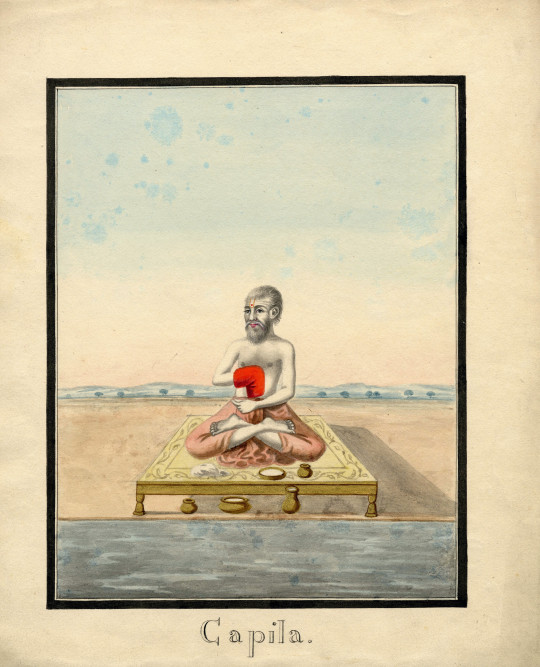
Samkhya or Sankya (/ˈsɑːŋkjə/; Sanskrit सांख्य), IAST: sāṅkhya) is a dualistic school of Indian philosophy.[1][2][3] It views reality as composed of two independent principles, puruṣa ('consciousness' or spirit); and prakṛti, (nature or matter, including the human mind and emotions).[4]
Puruṣa is the witness-consciousness. It is absolute, independent, free, beyond perception, above any experience by mind or senses, and impossible to describe in words.[5][6][7]
Unmanifest prakriti is matter or nature. It is inactive, unconscious, and is a balance of the three guṇas(qualities or innate tendencies),[8][9] namely sattva , rajas, and tamas. When prakṛti comes into contact with Purusha this balance is disturbed, and Prakriti becomes manifest, evolving twenty-three tattvas,[10] namely intellect (buddhi, mahat), ego (ahamkara) mind (manas); the five sensory capacities; the five action capacities; and the five "subtle elements" or "modes of sensory content" (tanmatras), from which the five "gross elements" or "forms of perceptual objects" (earth, water, fire, air and space) emerge,[8][11] in turn giving rise to the manifestation of sensory experience and cognition.[12][13]
Jiva ('a living being') is the state in which purusha is bonded to prakriti.[14] Human experience is an interplay of the two, purusha being conscious of the various combinations of cognitive activities.[14] The end of the bondage of purusha to prakriti is called liberation or kaivalya (isolation).[15] -- Wiki
Kapila is a Sage and founder of the Samkhya school. He lived sometime in (1500 BCE to 500 BCE), which places him before Buddha, and after Abraham of the Old Testament. His influence on Buddhist thought is the subject of much discussion.
#kapila#capila#samkya#samkhya#buddha#buddhism#philosophy#vedic#sage#indian#india#history#meditation#thought#mysticism
4 notes
·
View notes
Text
The Kaṭha Upaniṣad (3.9) compares the body to a chariot, the senses to the horses, the mind to the reins that control the horses, the buddhi to the driver who controls the reins and charts the course, and the puruṣa to the inactive passenger. Buddhi, intelligence; ahaṅkāra, ego; and manas, mind, together comprise the internal body (antaḥkaraṇa), the inner noetic world of thoughts, emotions, feelings, determination, will, cognitions, memories, etc. The puruṣa soul is cloaked in these psychic layers prior to receiving a gross body and senses. As noted, the Yoga school, while using the terminology of (especially) buddhi, but also ahaṅkāra and manas, differs somewhat from that of Sāṅkhya in conceiving these three as interacting functions of the one citta, mind, rather than as three distinct metaphysical layers. Citta, then, is the term used by Patañjali and the commentators to refer to all three of these cognitive functions combined (thus it is not a separate evolute from prakṛti).
[...]
According to Patañjali’s definition in the second sūtra, yoga is the cessation (nirodha) of the activities or permutations (vṛttis) of the citta. The vṛttis refer to any sequence of thought, ideas, mental imaging, or cognitive act performed by the mind, intellect, or ego as defined above—in short, any state of mind whatsoever. It cannot be over-stressed that the mind is merely a physical substance that selects, organizes, analyzes, and molds itself into the physical forms of the sense data presented to it; in and of itself it is not aware of them. Sense impressions or thoughts are imprints in that mental substance, just as a clay pot is a product made from the substance clay, or waves are permutations of the sea. The essential point for understanding yoga is that all forms or activities of the mind are products of prakṛti, matter, and completely distinct from the soul or true self, puruṣa, pure awareness or consciousness.
[...]
The citta can profitably be compared to the software, and the body to the hardware. Neither is conscious; they are rather forms of gross matter, even as the former can do very intelligent activities. Both software and hardware are useless without the presence of a conscious observer. Only puruṣa is truly alive, that is, aware or conscious. When uncoupled from the mind, the soul, puruṣa, in its pure state, that is, in its own constitutional, autonomous condition—untainted by being misidentified with the physical coverings of the body and mind—is free of content and changeless; it does not constantly ramble and flit from one thing to another the way the mind does. To realize pure awareness as an entity distinct and autonomous from the mind (and, of course, body), thought must be stilled and consciousness extracted from its embroilment with the mind and its incessant thinking nature. Only then can the soul be realized as an entity completely distinct from the mind (a distinction such clichés as “self-realization” attempt to express), and the process to achieve this realization is yoga.
-- Edwin F. Bryant, The Yoga Sutras of Patañjali
10 notes
·
View notes
Text
శ్రీమద్భగవద్గీత - 524: 13వ అధ్., శ్లో 35 / Bhagavad-Gita - 524: Chap. 13, Ver. 35
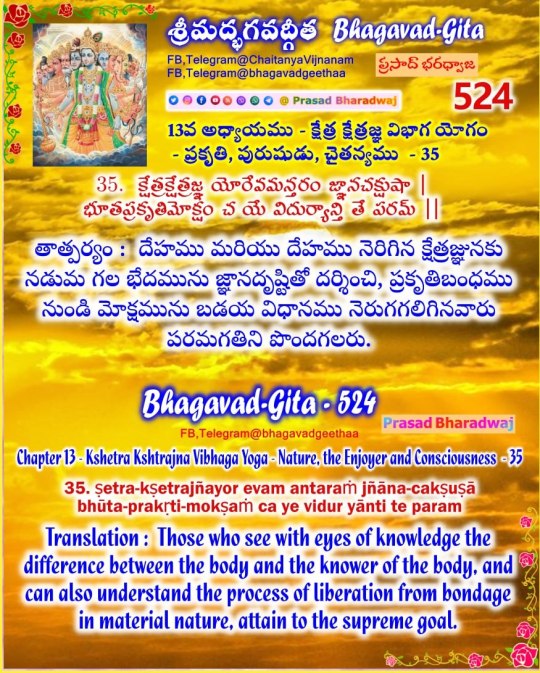
🌹. శ్రీమద్భగవద్గీత - 524 / Bhagavad-Gita - 524 🌹✍️. శ్రీ ప్రభుపాద, 📚. ప్రసాద్ భరద్వాజ
🌴. 13వ అధ్యాయము - క్షేత్ర క్షేత్రజ్ఞ విభాగ యోగం - ప్రకృతి, పురుషుడు, చైతన్యము - 35 🌴
35. క్షేత్రక్షేత్రజ్ఞయోరేవమన్తరం జ్ఞానచక్షుషా |
భూతప్రకృతిమోక్షం చ యే విదుర్యాన్తి తే పరమ్ ||
🌷. తాత్పర్యం : దేహము మరియు దేహము నెరిగిన క్షేత్రజ్ఞునకు నడుమ గల భేదమును జ్ఞానదృష్టితో దర్శించి, ప్రకృతిబంధము నుండి మోక్షమును బడయ విధానము నెరుగగలిగినవారు పరమగతిని పొందగలరు.
🌷. భాష్యము : దేహము, దేహయజమానియైన ఆత్మ, పరమాత్ముడు అనెడి మూడు అంశముల నడుమ గల భేదమును మనుజుడు తప్పక తెలిసికొనవలెనని పలుకుటయే ఈ త్రయోదశాయాధ్యాయపు సారాంశము. ఈ అధ్యాయమునందు ఎనిమిదవశ్లోకము నుండి పండ్రెండవ శ్లోకము వరకు వివరించిన మోక్షవిధానమును సైతము ప్రతియొక్కరు గుర్తింపవలెను. అంతటవారు పరమగతిని పొందగలరు. శ్రద్ధావంతుడైన మనుజుడు తొలుత సజ్జనసాంగత్యమును పొంది శ్రీకృష్ణభగవానుని గూర్చి శ్రవణము చేయవలెను. తద్ద్వారా అతడు క్రమముగా ఆత్మవికాసము నొందగలడు. మనుజుడు గురువును స్వీకరించినచో ఆత్మ మరియు అనాత్మల (భౌతికపదార్థము) నడుమగల వ్యత్యాసమును తెలియగలుగును. అది యంతట మరింత ఆధ్యాత్మికానుభూతికి సోపానము కాగలదు. జీవితపు భౌతిక భావన నుండి ముక్తులు కావలసినదిగా శిష్యులకు ఆధ్యాత్మికగురువు తన వివిధ ఉపదేశముల ద్వారా బోధనల కావించును.
ఈ దేహము భౌతికపదార్థమనియు మరియు ఇరువది నాలుగు తత్త్వములచే విశ్లేషణీయమనియు ఎవ్వరైనను గ్రహింపవచ్చును. ఆత్మ మరియు పరమాత్మ భిన్నులేగాని ఏకము కాదు. ఆత్మ మరియు ఇరువదినాలుగు భౌతికాంశముల సంయోగము చేతనే భౌతికజగత్తు నడుచుచున్నది. భౌతికజగమును ఈ విధమైన ఆత్మ మరియు చతుర్వింశతి తత్త్వముల కలయికగా గాంచుచు పరమాత్ముని నిజస్థితిని దర్శింపగలిగినవాడు ఆధ్యాత్మిక జగత్తును చేరుటకు అర్హుడగుచున్నాడు. ఈ విషయములన్నియును చింతనము మరియు ఆత్మానుభవము కొరకు ఉద్దేశింపబడియున్నవి. కనుక ఆధ్యాత్మికగురువు సహాయముచే ఈ అధ్యాయము నందలి విషయములను మనుజుడు సంపూర్ణముగా అవగాహనము చేసికొనవలెను.
శ్రీ మద్భగవద్గీత యందలి “క్షేత్ర క్షేత్రజ్ఞ విభాగ యోగం - ప్రకృతి, పురుషుడు, చైతన్యము” అను త్రయోదశాధ్యాయమునకు భక్తివేదాంత భాష్యము సమాప్తము.
🌹 🌹 🌹 🌹 🌹
🌹 Bhagavad-Gita as It is - 524 🌹
✍️ Sri Prabhupada, 📚 Prasad Bharadwaj
🌴 Chapter 13 - Kshetra Kshtrajna Vibhaga Yoga - Nature, the Enjoyer and Consciousness - 35 🌴
35. ṣetra-kṣetrajñayor evam antaraṁ jñāna-cakṣuṣā
bhūta-prakṛti-mokṣaṁ ca ye vidur yānti te param
🌷 Translation : Those who see with eyes of knowledge the difference between the body and the knower of the body, and can also understand the process of liberation from bondage in material nature, attain to the supreme goal.
🌹 Purport : The purport of this Thirteenth Chapter is that one should know the distinction between the body, the owner of the body, and the Supersoul. One should recognize the process of liberation, as described in verses 8 through 12. Then one can go on to the supreme destination. A faithful person should at first have some good association to hear of God and thus gradually become enlightened. If one accepts a spiritual master, one can learn to distinguish between matter and spirit, and that becomes the stepping-stone for further spiritual realization.
A spiritual master, by various instructions, teaches his students to get free from the material concept of life. For instance, in Bhagavad-gītā we find Kṛṣṇa instructing Arjuna to free him from materialistic considerations. One can understand that this body is matter; it can be analyzed with its twenty-four elements. The soul and the Supersoul are two. This material world is working by the conjunction of the soul and the twenty-four material elements. One who can see the constitution of the whole material manifestation as this combination of the soul and material elements and can also see the situation of the Supreme Soul becomes eligible for transfer to the spiritual world. These things are meant for contemplation and for realization, and one should have a complete understanding of this chapter with the help of the spiritual master.
Thus end the Bhaktivedanta Purports to the Thirteenth Chapter of the Śrīmad Bhagavad-gītā in the Kshetra Kshtrajna Vibhaga Yoga - Nature, the Enjoyer and Consciousness
🌹 🌹 🌹 🌹 🌹
0 notes
Text
🌹 16, MARCH 2024 SATURDAY ALL MESSAGES శనివారం, స్థిర వాసర సందేశాలు🌹
🍀🌹 16, MARCH 2024 SATURDAY ALL MESSAGES శనివారం, స్థిర వాసర సందేశాలు🌹🍀
🌹 16, MARCH 2024 SATURDAY ALL MESSAGES శనివారం, స్థిర వాసర సందేశాలు🌹
1) 🌹. శ్రీమద్భగవద్గీత - 509 / Bhagavad-Gita - 509 🌹
🌴. 13వ అధ్యాయము - క్షేత్ర క్షేత్రజ్ఞ విభాగ యోగం - ప్రకృతి, పురుషుడు, చైతన్యము - 20 / Chapter 13 - Kshetra Kshtrajna Vibhaga Yoga - Nature, the Enjoyer and Consciousness - 20 🌴
2) 🌹. శ్రీ శివ మహా పురాణము - 864 / Sri Siva Maha Purana - 864 🌹
🌻. శంఖచూడుని దూత శివునితో సంభాషించుట - 1 / The conversation between Śiva and the emissary of Śaṅkhacūḍa - 1 🌻
3) 🌹. ఓషో రోజువారీ ధ్యానాలు - 122 / Osho Daily Meditations - 122 🌹
🍀 122. ఆనందం మరియు బాధల మధ్య / 122. BETWEEN PLEASURE AND PAIN 🍀
4) 🌹. శ్రీ లలితా చైతన్య విజ్ఞానము - 538-1 / Sri Lalitha Chaitanya Vijnanam - 538-1 🌹
🌻 538. 'మేధా’ - 1 / 538. 'Medha' - 1🌻
5) 🌹 సిద్దేశ్వరయానం - 16 🌹
🍀🌹🍀🌹🍀🌹🍀🌹🍀🌹
🍀🌹🍀🌹🍀🌹🍀🌹🍀🌹

🌹. శ్రీమద్భగవద్గీత - 509 / Bhagavad-Gita - 509 🌹
✍️. శ్రీ ప్రభుపాద, 📚. ప్రసాద్ భరద్వాజ
🌴. 13వ అధ్యాయము - క్షేత్ర క్షేత్రజ్ఞ విభాగ యోగం - ప్రకృతి, పురుషుడు, చైతన్యము - 20 🌴
20. ప్రకృతిం పురుషం చైవ విద్ధ్యనాదీ ఉభావపి |
వికారాంశ్చ గుణాంశ్చైవ విద్ధి ప్రకృతిసమ్భవాన్ ||
🌷. తాత్పర్యం : జీవులు మరియు భౌతికప్రకృతి రెండును అనాది యని తెలిసికొనవలెను. వాని యందలి పరివర్తనములు మరియు భౌతికగుణము లనునవి భౌతికప్రకృతి నుండి ఉద్భవించినవి.
🌷. భాష్యము : ఈ అధ్యాయమునందు తెలుపబడిన జ్ఞానము ద్వారా మనుజుడు కర్మక్షేత్రము (దేహము) మరియు దేహము నెరిగిన క్షేత్రజ్ఞులను (జీవాత్మ, పరమాత్మ) గూర్చి తెలిసికొన వచ్చును.
కర్మక్షేత్రమైన దేహము భౌతికప్రకృతినియమమై నట్టిది. దాని యందు బద్ధుడై దేహకర్మల ననుభవించు ఆత్మయే పురుషుడు(జీవుడు). అతడే జ్ఞాత. అతనితోపాటు గల వేరొక జ్ఞాతయే పరమాత్ముడు. కాని ఈ ఆత్మా, పరమాత్మ రూపములు దేవదేవుడైన శ్రీకృష్ణుని భిన్న వ్యక్తీకరణములే యని మనము అవగాహనము చేసికొనవలెను. ఆత్మా ఆ భగవానుని శక్తికి సంబంధించినది కాగా, పరమాత్మ రూపము అతని స్వీయ విస్తృతరూపమై యున్నది
🌹 🌹 🌹 🌹 🌹
*🌹 Bhagavad-Gita as It is - 509 🌹
*✍️ Sri Prabhupada, 📚 Prasad Bharadwaj*
🌴 Chapter 13 - Kshetra Kshtrajna Vibhaga Yoga - Nature, the Enjoyer and Consciousness - 20 🌴
20. prakṛtiṁ puruṣaṁ caiva viddhy anādī ubhāv api
vikārāṁś ca guṇāṁś caiva viddhi prakṛti-sambhavān
🌷 Translation : Material nature and the living entities should be understood to be beginningless. Their transformations and the modes of matter are products of material nature.
🌹 Purport : By the knowledge given in this chapter, one can understand the body (the field of activities) and the knowers of the body (both the individual soul and the Supersoul).
The body is the field of activity and is composed of material nature. The individual soul that is embodied and enjoying the activities of the body is the puruṣa, or the living entity. He is one knower, and the other is the Supersoul. Of course, it is to be understood that both the Supersoul and the individual entity are different manifestations of the Supreme Personality of Godhead. The living entity is in the category of His energy, and the Supersoul is in the category of His personal expansion.
🌹 🌹 🌹 🌹 🌹
🍀🌹🍀🌹🍀🌹🍀🌹🍀🌹
🍀🌹🍀🌹🍀🌹🍀🌹🍀🌹
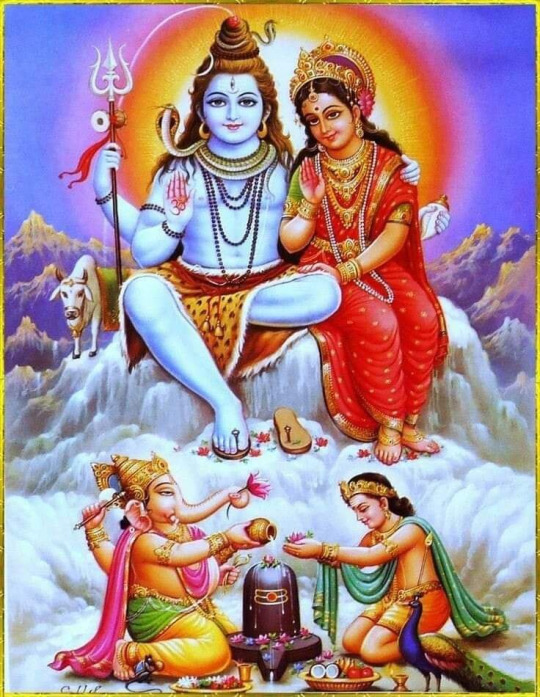
🌹 . శ్రీ శివ మహా పురాణము - 864 / Sri Siva Maha Purana - 864 🌹
✍️. స్వామి తత్త్వ విదానంద సరస్వతి 📚. ప్రసాద్ భరద్వాజ
🌴. రుద్రసంహితా-యుద్ద ఖండః - అధ్యాయము - 35 🌴
🌻. శంఖచూడుని దూత శివునితో సంభాషించుట - 1 🌻
సనత్కుమారుడిట్లు పలికెను - ఆ రాక్షసరాజు అక్కడ మకాము చేసి, మహాజ్ఞాని యగు ఒక గొప్ప దానవశ్రేష్ఠుని శివుని వద్దకు దూతగా పంపెను (1).
ఆ దూత అచటకు వెళ్లి, ఫాలభాగమునందు చంద్రవంక గలవాడు, వట వృక్షమూలము నందు కూర్చున్నవాడు, కోటి సూర్యులతో సమానముగు కాంతి గలవాడు (2), యోగాసనమును వేసి కనులతో ముద్రను ప్రదర్శించువాడు, చిరునగవు మోమువాడు, స్వచ్ఛమగు స్ఫటికమును బోలియున్నవాడు, బ్రహ్మతేజస్సుతో వెలిగి పోవుచున్న వాడు (3), త్రిశూలమును పట్టిశమును పట్టుకున్న వాడు, వ్యాఘ్రచర్మమును వస్త్రముగా దాల్చినవాడు, భక్తుల మృత్యువును పోగోట్టువాడు, శాంతస్వరూపుడు, గౌరీప్రియుడు, ముక్కంటి (4), తపస్సుల ఫలములనిచ్చువాడు, సర్వసంపదలను కలిగించువాడు, శీఘ్రముగా సంతోషించువాడు, ప్రసన్నమగు మోముగలవాడు, భక్తులను అనుగ్రహించువాడు (5) , జగత్తునకు తండ్రి, జగత్తునకు కారణము, జగత్ స్వరూపములో నున్నవాడు, సర్వమునుండి పుట్టువాడు,సర్వమును పాలించువాడు, సర్వమునకు కర్త, జగత్తును ఉపసంహరించు వాడు (6), సర్వకారణ కారణుడు, పాపసముద్రమును దాటించువాడు, జ్ఞానమునిచ్చువాడు, జ్ఞానమునకు కారణుడు, జ్ఞాన-ఆనంద స్వరూపడు, అద్యంతములు లేనివాడు (7) అగు శంకరుడు కుమారస్వామితో కూడియుండగా చూచెను. దూతయగు ఆ దానవీరుడు రథమునుండి దిగి ఆయనకు శిరము వంచి ప్రణమిల్లెను (8).
ఆయనకు ఎడమవైపున భద్రకాళి, ఎదుట కుమారస్వామి ఉండిరి. లోకమర్యాదనను సరించి కాళి, కుమారస్వామి, మరియు శంకరుడు ఆతనిని ఆశీర్వదించిరి (9). గొప్ప శాస్త్రవేత్తయగు, శంఖచూడుని దూత అపుడు చేతులు జోడించి శంకరునకు ప్రణమిల్లి ఈ శుభవచనములను పలికెను (10).
సశేషం….
🌹 🌹 🌹 🌹 🌹
🌹 SRI SIVA MAHA PURANA - 864 🌹
*✍️ J.L. SHASTRI, 📚. Prasad Bharadwaj *
🌴 Rudra-saṃhitā (5): Yuddha-khaṇḍa - CHAPTER 35 🌴
🌻 The conversation between Śiva and the emissary of Śaṅkhacūḍa - 1 🌻
Sanatkumāra said:—
Stationing himself there, the lord of Dānavas sent a leading Dānava of great knowledge as his emissary to Śiva.
The emissary went there and saw the moon-crested lord Śiva, of the refulgence of a crore suns, seated at the root of the Banyan tree.
He saw him sitting in a yogic pose, showing the mystic gesture with his eyes, with a smiling face and body as pure as crystal and blazing with transcendent splendour.
4-7. Śiva held the trident and the iron club. He was clad in the hide of the tiger. The emissary saw the three-eyed lord of Pārvatī, the enlivener of the life of the devotees, the quiet Śiva, the dispenser of the fruits of penance, the creator of riches, quick in being propitiated, eager to bless the devotees and beaming with pleasure in his face. He saw the lord of the universe, the seed of the universe, identical with the universe and of universal form, born of all, lord of all, creator of all, the cause of the annihilation of the universe, the cause of causes, the one who enables devotees to cross the ocean of hell, the bestower of knowledge, the seed of knowledge, knowlege-bliss and eternal.
On seeing him, the messenger, the leader of Dānavas, descended from his chariot and bowed to him as well as to Kumāra.
He saw Bhadrakālī to his left and Kārttikeya standing before him. Kālī, Kārttikeya and Śiva offered him the conventional benediction.
This emissary of Śaṅkhacūḍa, had full knowledge of the sacred texts. He joined his palms in reverence and bowing to him spoke the auspicious words.
Continues….
🌹🌹🌹🌹🌹
🍀🌹🍀🌹🍀🌹🍀🌹🍀🌹
🍀🌹🍀🌹🍀🌹🍀🌹🍀🌹

🌹. ఓషో రోజువారీ ధ్యానాలు - 122 / Osho Daily Meditations - 122 🌹
✍️. ప్రసాద్ భరద్వాజ
🍀 122. ఆనందం మరియు బాధల మధ్య 🍀
🕉 ఒక వ్యక్తి శాశ్వత నివాసిగా మారగల ఏకైక చోటు ఇది లేదా అది కానిది. 🕉
ఈ స్థలంలో నిశ్శబ్దం మరియు ప్రశాంతత యొక్క నాణ్యత ఉంది. నిజానికి, ప్రారంభంలో ఇది చాలా రుచి లేనట్లు అనిపిస్తుంది, ఎందుకంటే నొప్పి లేదు, ఆనందం లేదు. కానీ మొత్తం బాధ మరియు మొత్తం ఆనందం కేవలం ఉత్సాహం. మీకు నచ్చిన ఉత్సాహాన్ని మీరు ఆనందం అంటారు. మీకు నచ్చని ఉత్సాహాన్ని మీరు నొప్పి అంటారు. కొన్నిసార్లు మీరు ఒక నిర్దిష్ట ఉత్సాహాన్ని ఇష్టపడటం ప్రారంభించవచ్చు మరియు అది ఆనందంగా మారవచ్చు మరియు మీరు మరొక ఉత్సాహాన్ని ఇష్టపడటం ప్రారంభించవచ్చు మరియు అది నొప్పిగా మారవచ్చు. కాబట్టి అదే అనుభవం బాధగా లేదా ఆనందంగా మారవచ్చు; ఇది మీ ఇష్టాయిష్టాలపై ఆధారపడి ఉంటుంది.
ఆనందం మరియు బాధ మధ్య ఖాళీలో విశ్రాంతి తీసుకోండి. అది విశ్రాంతి యొక్క అత్యంత సహజమైన స్థితి. మీరు దానిలో ఉండటం ప్రారంభించిన తర్వాత, అనుభూతి చెందడం మొదలుపెట్టాక, మీరు దాని రుచిని నేర్చుకుంటారు. దాన్నే నేను టావో రుచి అంటాను. ఇది వైన్ లాంటిది. ప్రారంభంలో చాలా చేదుగా ఉంటుంది. మీరు నేర్చుకోవాలి. మరియు అది గాఢమైన వైన్, నిశ్శబ్దం, ప్రశాంతత యొక్క గొప్ప మద్య పానీయం. దానితో మీరు మత్తులోకి వెడతారు. దాని రుచి క్రమంగా మీకే అర్థమవుతుంది. మీ నాలుక చాలా బాధ మరియు ఆనందంతో నిండినందున ప్రారంభంలో అది రుచిగా ఉండదు.
కొనసాగుతుంది…
🌹 🌹 🌹 🌹 🌹
🌹 Osho Daily Meditations - 122 🌹
📚. Prasad Bharadwaj
🍀 122. BETWEEN PLEASURE AND PAIN 🍀
🕉 The only state in which one can become a permanent dweller is the space that is neither this nor that. 🕉
In this space is a quality of silence and tranquility. Of course, in the beginning it feels very tasteless, because there is no pain and no pleasure. But all pain and all pleasure is just excitement. The excitement that you like, you call pleasure. The excitement that you don't like, you call pain. Sometimes it happens that you can start liking a certain excitement and it may become pleasure, and you can start liking another excitement and it may turn into pain. So the same experience can become pain or pleasure; it depends on your likes and dislikes.
Relax in the space between pleasure and pain. That's the most natural state of relaxation. Once you start being in it, feeling it, you will learn the taste of it. That is what I call the taste of Tao. It is just like wine. In the beginning it will be very bitter. One has to learn. And it is the deepest wine there is, the greatest alcoholic beverage of silence, of tranquility. One becomes drunk with it. By and by you will understand the taste of it. In the beginning it is tasteless, because your tongue is too full of pain and pleasure.
Continues…
🌹 🌹 🌹 🌹 🌹
🍀🌹🍀🌹🍀🌹🍀🌹🍀🌹
🍀🌹🍀🌹🍀🌹🍀🌹🍀🌹
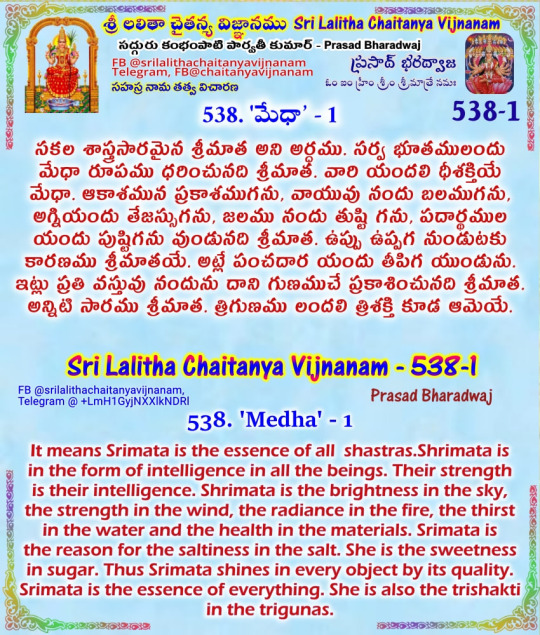
🌹. శ్రీ లలితా చైతన్య విజ్ఞానము - 538 - 1 / Sri Lalitha Chaitanya Vijnanam - 538 - 1 🌹
🌻. లలితా సహస్ర నామముల తత్వ విచారణ 🌻
✍️. సద్గురు శ్రీ కంభంపాటి పార్వతీ కుమార్
సేకరణ : ప్రసాద్ భరద్వాజ
🍁. మూల మంత్రము : ఓం ఐం హ్రీం శ్రీం శ్రీమాత్రే నమః 🍁
🍀 110. సర్వౌదన ప్రీతచిత్తా, యాకిన్యంబా స్వరూపిణీ ।
స్వాహా, స్వధా, అమతి, ర్మేధా, శ్రుతిః, స్మృతి, రనుత్తమా ॥ 110 ॥ 🍀
🌻 538. 'మేధా’ - 1 🌻
సకల శాస్త్రసారమైన శ్రీమాత అని అర్ధము. సర్వ భూతములందు మేధా రూపము ధరించునది శ్రీమాత. వారి యందలి ధీశక్తియే మేధా. ఆకాశమున ప్రకాశముగను, వాయువు నందు బలముగను, అగ్నియందు తేజస్సుగను, జలము నందు తుష్టి గను, పదార్థములయందు పుష్టిగను వుండునది శ్రీమాత. ఉప్పు ఉప్పగ నుండుటకు కారణము శ్రీమాతయే. అట్లే పంచదార యందు తీపిగ యుండును. ఇట్లు ప్రతి వస్తువు నందును దాని గుణముచే ప్రకాశించునది శ్రీమాత. అన్నిటి సారము శ్రీమాత. త్రిగుణము లందలి త్రిశక్తి కూడ ఆమెయే.
సశేషం…
🌹 🌹 🌹 🌹 🌹
🌹 Sri Lalitha Chaitanya Vijnanam - 538 - 1 🌹
Contemplation of 1000 Names of Sri Lalitha Devi
✍️ Prasad Bharadwaj
🌻 110. Sarvaodana pritachitta yakinyanba svarupini
svahasvadha amati rmedha shrutih smrutiranuttama ॥110 ॥ 🌻
🌻 538. 'Medha' - 1 🌻
It means Srimata is the essence of all shastras.Shrimata is in the form of intelligence in all the beings. Their strength is their intelligence. Shrimata is the brightness in the sky, the strength in the wind, the radiance in the fire, the thirst in the water and the health in the materials. Srimata is the reason for the saltiness in the salt. She is the sweetness in sugar. Thus Srimata shines in every object by its quality. Srimata is the essence of everything. She is also the trishakti in the trigunas.
Continues…
🌹 🌹 🌹 🌹 🌹
🍀🌹🍀🌹🍀🌹🍀🌹🍀🌹
🍀🌹🍀🌹🍀🌹🍀🌹🍀🌹

🌹 సిద్దేశ్వరయానం - 16 🌹
💐 శ్రీ సిద్దేశ్వరానంద భారతీ స్వామి విరచిత 💐
🏵 భైరవనాథుడు 🏵
ఒక నాటి సాయంకాలం జైగీషవ్యేశ్వరునకు పూజ చేసి అర్చకుడు నీరాజనం ఇస్తున్నాడు. ఈ యువకుడు కూడా హారతి కొరకు వచ్చాడు. అదే సమయానికి ఋషివలె జటాజూటముతో ఉన్న ఒక యోగి శిష్యులతో వచ్చి శివునకు నమస్కరించి నిలుచున్నాడు. పెద్దవారువచ్చారని ఒక ఉన్నతాసనం వేసి కూర్చోమని ప్రార్థించారక్కడి భక్తులు. ఆ యోగి శివమహిమ గూర్చి కొద్ది మాటలు చెప్పి కాసేపు భజన చేయించాడు. ఇతడు కూడా సాష్టాంగ నమస్కారం చేసి గుహలోకి వెళ్ళకుండా వారి దగ్గర కూర్చోవాలనిపించి కూర్చున్నాడు. కాసేపయిన తర్వాత జనమంతా వెళ్ళిపోయినారు. వారి శిష్యులు నలుగురు మాత్రం ఉన్నారు. ఆ యోగి వాళ్ళను దూరంగా వెళ్ళి ఉండమని చెప్పి ఈ యువకుని పలకరించాడు.
"నాయనా! నాగేశ్వరా ! తపస్సు బాగా సాగుతున్నది గదా! దివ్యానుభవాలు రావటం, శరీరంలోకి శక్తితరంగాలు ప్రసరించడం కూడా మొదలయినది గదా!" యువకుడాశ్చరపడినాడు. “మహాత్మా! ఇక్కడ నాపేరెవ్వరికీ తెలియదు. నా సాధన రహస్యాలతో సహా అన్నీ మీరు తెలుసుకొని చెప్పుతున్నారు. నా భవిష్యత్తు ఏమిటో అవగతం కావటం లేదు. కర్తవ్యోపదేశం చేయమని వేడుకుంటున్నాను” అని ఆ ఋషిపాదములపై పడినాడు. ఆయన లేవనెత్తి ఎదురుగా కూర్చోమని భ్రూమధ్యాన్ని తన వేలితో స్పృశించాడు. తరుణునకు తలగిర్రున తిరగటం మొదలు పెట్టింది. కనులు మూతలు పడినవి.
అనంతమైన కాంతిపుంజం. కపాలమాలాధరుడు, వజ్రహస్తుడు, నాగాలంకృతుడు అరుణకేశుడు అయిన కాలభైరవుడు సాక్షాత్కరించాడు. యక్షరాక్షసులు, విద్యాధర గంధర్వులు ఆ దేవదేవుని సేవిస్తున్నారు. ఆయన వాహనమైన శ్వానరాజు ప్రసన్నుడై చూస్తున్నాడు. గంధర్వ కిన్నరులు ఆస్వామిని స్తోత్రం చేస్తున్నారు.
భైరవస్వామి దయార్ద్ర దృక్కులతో పలుకుతున్నాడు. “వామదేవా! సరియైన సమయానికి ఈ యువకుని దగ్గరకు వచ్చావు. ఇతనిని సిద్ధాశ్రమానికి తీసుకువెళ్లి తగిన శిక్షణ యిచ్చి ధర్మవీరునిగా తీర్చిదిద్ది కృష్ణభూమిని కాపాడటానికి నియోగించు కర్తవ్యోన్ముఖుని చెయ్యి!” అని యువకుని ప్రసన్నముఖుడై ఆశీర్వదించి అదృశ్యుడైనాడు.
యువకునకు కంటివెంట నీరు కారుతున్నది. “మహర్షీ! మహాను భావులైన మీ కరుణవల్ల భైరవ దర్శనం కలిగింది. స్వామి చెప్పిన కృష్ణభూమి రక్షణ వంటి విషయాలు నాకు అర్థం కాలేదు. గురుదేవులు - మీరు. నేనేం చెయ్యాలో ఆదేశించండి. ఆజ్ఞాపించండి!". మహర్షి "నాగేశ్వరా! ఈ అనుభూతి వల్ల నీ మార్గం నీకు తెలుస్తున్నది. ఇప్పుడు నిశా సమయం. నీకు చెప్పవలసినవి నీవు తెలుసుకోవలసినవి చాలా ఉన్నవి. చేయవలసిన సాధన ముందున్నది. నే నిక్కడే ఈ జైగీషవ్యేశ్వరుని ముందు ధ్యానసమాధిలో ఉంటాను. తెల్లవారుజామున బయలుదేరి నీవు నాతో హిమాలయాలలోని సిద్ధాశ్రమానికి వస్తున్నావు. దానికి సిద్ధంకా!” యువకుడు "మీ ఆజ్ఞ” అని పాద నమస్కారం చేశాడు.
ఉదయం.
ఉషస్స్యాత్ గార్గ్య సిద్ధాంతం శకునంతు బృహస్పతేః
మనశ్శుద్ధి ర్వ్యాసమతం విప్రవాక్యం హరేర్మతం
అభిజిత్ సర్వసంజ్ఞాతం*.
ఎవరైనా ప్రయాణం పెట్టుకొంటే ఉషఃకాలంలో బయలుదేరితే ఏ ఆటంకాలు లేకుండా సాగుతుందని గార్గ్యవచనం. శకునం చూచుకొని బయలుదేరమని బృహస్పతి పలికాడు. మంచి శకునం ఉంటుందో లేదోనని కొంతమంది ప్రక్క యింటి ముత్తయిదువను పిలిచి "అమ్మా! మా అబ్బాయి కార్యార్థియై బయలుదేరుతున్నాడు ఎదురుగా రా” అని శుభశకునం ఏర్పాటు చేసుకొంటారు. మనశ్శుద్ధి ఉంటే అంతా సవ్యంగా జరుగుతుందని వ్యాసుడు అన్నాడు.
పరీక్షలకు, ఉద్యోగాలకు వెళ్ళేవారికి మనస్సు నిర్మలంగా ఎందుకుంటుంది? భయం భయంగా ఉండవచ్చు. అందుకని “విప్రవాక్యం హరేర్మతం"అన్నారు. అంటే పెద్దల ఆశీస్సులు తీసుకొని బయలుదేరాలని అర్థం. మనోబలం ఉంటే చాలునని మాండవ్యుడు అన్నాడు. అభిజిల్లగ్నం అయితే తిథి వార నక్షత్రాలు, శకునాలు ఏమీ చూడనక్కరలేదట! సూర్యుడు నడినెత్తిన ఉండి మన నీడ మన క్రిందనే ఉండే సమయం. పల్లెటూళ్ళలో దీనిని గడ్డపారలగ్నం అంటారు. అంటే గడ్డపార నేలమీద పాతితే దానినీడ అక్కడే ��్రక్కకు పోకుండా ఉండే కాలం.
( సశేషం )
🌹🌹🌹🌹🌹
🍀🌹🍀🌹🍀🌹🍀🌹🍀🌹
🍀🌹🍀🌹🍀🌹🍀🌹🍀🌹
0 notes
Text
Yoga as a State of Being
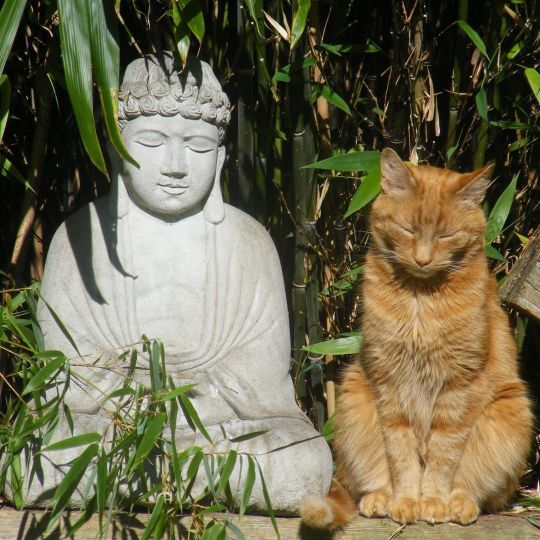
We now find ourselves in an age in which more people are practicing yoga than ever before, the term yoga here having become more or less synonymous with postural āsana practice. There are a bewildering array of yoga styles out there, each one trying to make their mark. Yoga appears in glossy magazines and on YouTube and TV programmes and yoga studios have cropped up all over the place in most cities. At least 12,000 ‘yogis’ turn up at Times Square in New York twice a year to practice āsana en-masse. These days it sometimes feels like almost everyone is doing yoga (an exaggeration, I know). Yet, the question has to be asked, is what they are ‘doing’ really yoga?
To answer this question, it may be useful to try and more clearly define what we mean by ‘yoga’. This in itself is a tricky business! First off, is there something tangible, a set of practices and worldviews that we can point to and say conclusively ‘ah-ha, that’s yoga’? Or does the term yoga, as I suspect, refer to something more encompassing, more primordial even, to that yearning to find one’s place in the universe that has arisen amongst all humans in all times and cultures? These days we often hear people say something like “I’m off to do my yoga”. In the very early history of yoga this phrase would not have made much sense. Mostly, yoga was not something you did, but more often referred to a state of being, something you were at the core of your being, and the word was often used interchangeably with samādhi. I think it is important to fully understand this point, that yoga is ultimately the goal, that which we aim to attain, through whatever means and whatever practices seem right for us. The truth is, in its long history yoga can and has been defined in many different ways, as even a cursory look through this history will attest.

We might begin this journey sifting through the rather questionable ‘evidence’ presented by pre-Vedic archaeological finds from the Indus Valley Civilisation and early Vedic texts, where we meet the long-haired sages and vrātyas who some claim to be proto-yogis. Much scholarly research is now suggesting that the origins of the practices and concepts of yoga may have originated amongst the ascetic groups known as the śramaṇas, such as the Buddhists, Jains and Ājīvikas, although they didn’t actually use the term yoga. Our next hard evidence of yoga appears in the genre of texts known as the Upaniṣads where the first clear reference to yoga (in the Kaṭha Upaniṣad) defines it as firm restraint of the senses, a state in which one becomes completely undistracted by the outside world. Within the Bhagavad Gītā, we see yoga defined in a multitude of ways, including in this sense-withdrawal guise, but also as separation from suffering and also as ‘skill in action’ in the context of karma yoga. In Sāṃkhya and subsequently in the Yoga Sūtras the aim of yoga becomes ‘the stilling of the turnings of mind’ and the separation or isolation (kaivalya) of our true self or puruṣa from the everyday material world of prakṛti, and explicitly not becoming ‘one with everything’ which is in fact a more Vedāntic, Tantric and New Age notion.
Later on, yoga becomes inflected with a new set of meanings from the Nondual Śaiva Tantric traditions. The aim of yoga here becomes any practice aimed towards the achievement of that heightened state of awareness where one can perceive the Divine in all things, all situations, and all beings, including oneself. Later still, we come to the tradition of Haṭha yoga. Ironically, the name of this style of yoga which is now usually promoted as a ‘gentle’ yoga in most yoga studios, actually literally means something like ‘forceful yoga’. The overarching aim here remains one of ultimate liberation, but to reach this all kinds of bodily practices are employed, and in some strands of the tradition at least these are geared towards raising the kuṇḍalinī energy up the suṣumṇā nāḍi, awakening the c̣akras as it goes. Here, the division of four yogas, with rāja yoga placed highest, first appears. Though bodily health and longevity are promised as benefits of Haṭha yoga these are hardly seen as the ultimate goal. Indeed, it can be said with some confidence that health related aims (admirable as these may be) do not take on any considerable significance until we get to the present age, within the last century or so. Nowadays, yoga is very much embedded within the Health and Wellbeing industry and we have seen the rise of ‘fitness yoga’, for want of a better term.
So, what is yoga, and can it even be said to have a definable essence? For me, yoga describes a state of being that is innate, natural and primordial. Yoga is not even something to strive for or towards because each one of us has yoga at the very core of our being. In prehistoric times I believe we were all naturally engaged in yoga, and by saying this I certainly don’t want to portray a rose-tinted view of the past in which life was perfect and peaceful, that’s absurd, but I do think we would have been more deeply connected with the source, with the ground of Being, that puruṣa, brahman, Śiva, God, Pure Awareness, call it what you will. In the modern technological age, we have more and more distractions that prevent us from realising and abiding in this true state. This does not necessarily mean that the modern age is all bad, again that’s just absurd, it just means we have to work much harder to regain this state of yoga. And again, this is not really the right wording, because we are not actually re-gaining anything, as yoga is always with us, it is simply veiled or covered to varying degrees.

Having as I do a preference for the Nondual Śaiva Tantra view of things, I also happen to believe that rediscovering the state of yoga does not mean renouncing or closing oneself off from the world, to the contrary, it means opening up fully to the universe and all the wondrous potentiality it contains. If one could see the Divine working creatively through everything (including oneself) in every single moment, whether enjoying a beautiful beach, cleaning a toilet, or doing a headstand or whatever one does in life… then one would know one was truly living in yoga. We might rediscover that lost state through dancing or whilst washing the dishes, we might rediscover it through sitting in deep meditation, and yes, we might rediscover it through standing on our heads! Who cares how we find it? Yoga is a destination with many paths, and now is hardly the time to bicker about which path is superior.
As a species, we stand at a crossroads. Our egotistical desire to control and manipulate everything has left us at the edge of destruction. I know it all sounds a bit grand but maybe, just maybe, rediscovering this state of yoga, this state of equilibrium and joyous exuberance in all-pervading Divinity, will be the thing that can save us...
By Dr. Benjamin Major
#yoganaturesheffieldblog#yoga philosophy#yogaasastateofbeing#yogahistory#yogainspiration#yogaforrelaxation#nonduality#whatisyoga#yogaislife
0 notes
Text
కపిల గీత - 283 / Kapila Gita - 283
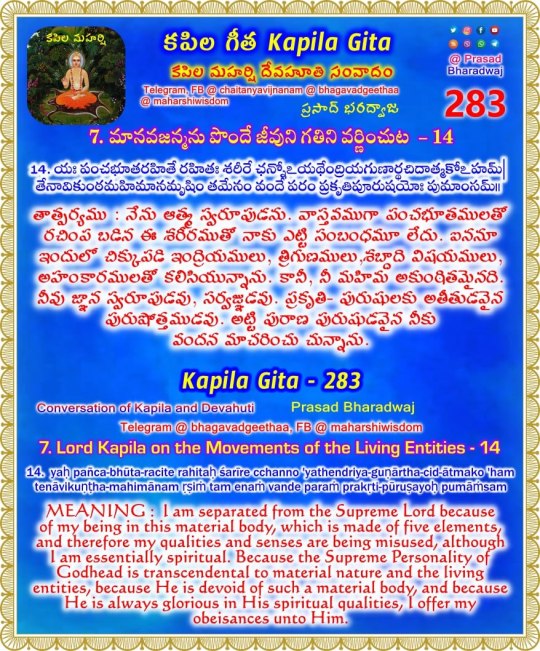
🌹. కపిల గీత - 283 / Kapila Gita - 283 🌹
🍀. కపిల దేవహూతి సంవాదం 🍀
✍️. ప్రసాద్ భరధ్వాజ
🌴 7. మానవజన్మను పొందే జీవుని గతిని వర్ణించుట - 14 🌴
14. యః పంచభూతరహితే రహితః శరీరే ఛన్నోఽయథేంద్రియగుణార్థచిదాత్మకోఽహమ్|
తేనావికుంఠమహిమానమృషిం తమేనం వందే పరం ప్రకృతిపూరుషయోః పుమాంసమ్॥
తాత్పర్యము : నేను ఆత్మ స్వరూపుడను. వాస్తవముగా పంచభూతములతో రచింప బడిన ఈ శరీరముతో నాకు ఎట్టి సంబంధమూ లేదు. ఐననూ ఇందులో చిక్కుపడి ఇంద్రియములు, త్రిగుణములు,శబ్దాది విషయములు, అహంకారములతో కలిసియున్నాను. కానీ, నీ మహిమ అకుంఠితమైనది. నీవు జ్ఞాన స్వరూపుడవు, సర్వజ్ఞుడవు. ప్రకృతి- పురుషులకు అతీతుడవైన పురుషోత్తముడవు. అట్టి పురాణ పురుషుడవైన నీకు వందన మాచరించు చున్నాను.
వ్యాఖ్య : జీవుడు మరియు పరమాత్ముని మధ్య వ్యత్యాసం ఏమిటంటే, జీవుడు భౌతిక ప్రకృతికి లోనయ్యే అవకాశం ఉంది, అయితే పరమాత్మ ఎల్లప్పుడూ భౌతిక ప్రకృతికి అలాగే జీవులకు అతీతంగా ఉంటాడు. జీవుడు భౌతిక ప్రకృతిలో ఉంచబడినప్పుడు, అతని ఇంద్రియాలు మరియు గుణాలు కలుషితమవుతాయి లేదా నియమించ బడతాయి. భగవంతుడు భౌతిక గుణాలు లేదా భౌతిక ఇంద్రియాల ద్వారా మూర్తీభవించే అవకాశం లేదు, ఎందుకంటే అతను భౌతిక స్వభావం యొక్క ప్రభావానికి అతీతుడు మరియు జీవుల వలె అజ్ఞానపు చీకటిలో ఉంచలేడు. అతని పూర్తి జ్ఞానం కారణంగా, అతను భౌతిక స్వభావం యొక్క ప్రభావానికి ఎన్నడూ లోబడి ఉండడు. భౌతిక స్వభావం ఎల్లప్పుడూ అతని ఆధీనంలో ఉంటుంది, కాబట్టి భౌతిక ప్రకృతి పరమాత్మను నియంత్రించడం సాధ్యం కాదు.
జీవుని యొక్క గుర్తింపు చాలా సూక్ష్మమైనది కనుక, అతడు భౌతిక ప్రకృతికి లోనయ్యే అవకాశం ఉంది, కానీ అతడు అసత్యమైన ఈ భౌతిక శరీరం నుండి విముక్తి పొందినప్పుడు, అతను ఆధ్యాత్మిక స్వభావాన్ని పొందుతాడు. ఆ సమయంలో అతనికి మరియు పరమేశ్వరునికి మధ్య గుణాత్మక భేదం లేదు, కానీ అతను భౌతిక స్వభావం యొక్క ప్రభావానికి లోనయ్యేంత పరిమాణాత్మకంగా శక్తివంతమైనవాడు కానందున, అతను భగవంతుని నుండి పరిమాణాత్మకంగా భిన్నంగా ఉంటాడు.
సశేషం..
🌹 🌹 🌹 🌹 🌹
🌹 Kapila Gita - 283 🌹
🍀 Conversation of Kapila and Devahuti 🍀
📚 Prasad Bharadwaj
🌴 7. Lord Kapila's Instructions on the Movements of the Living Entities - 14 🌴
14. yaḥ pañca-bhūta-racite rahitaḥ śarīre cchanno 'yathendriya-guṇārtha-cid-ātmako 'ham
tenāvikuṇṭha-mahimānam ṛṣiṁ tam enaṁ vande paraṁ prakṛti-pūruṣayoḥ pumāṁsam
MEANING : I am separated from the Supreme Lord because of my being in this material body, which is made of five elements, and therefore my qualities and senses are being misused, although I am essentially spiritual. Because the Supreme Personality of Godhead is transcendental to material nature and the living entities, because He is devoid of such a material body, and because He is always glorious in His spiritual qualities, I offer my obeisances unto Him.
PURPORT : The difference between the living entity and the Supreme Personality of Godhead is that the living entity is prone to be subjected to material nature, whereas the Supreme Godhead is always transcendental to material nature as well as to the living entities. When the living entity is put into material nature, then his senses and qualities are polluted, or designated. There is no possibility for the Supreme Lord to become embodied by material qualities or material senses, for He is above the influence of material nature and cannot possibly be put in the darkness of ignorance like the living entities. Because of His full knowledge, He is never subjected to the influence of material nature. Material nature is always under His control, and it is therefore not possible that material nature can control the Supreme Personality of Godhead.
Since the identity of the living entity is very minute, he is prone to be subjected to material nature, but when he is freed from this material body, which is false, he attains the same, spiritual nature as the Supreme Lord. At that time there is no qualitative difference between him and the Supreme Lord, but because he is not so quantitatively powerful as to never be put under the influence of material nature, he is quantitatively different from the Lord.
Continues...
🌹 🌹 🌹 🌹 🌹
0 notes
Video
youtube
Om Hari Om Gopala Krishna ~ George Harrison ~
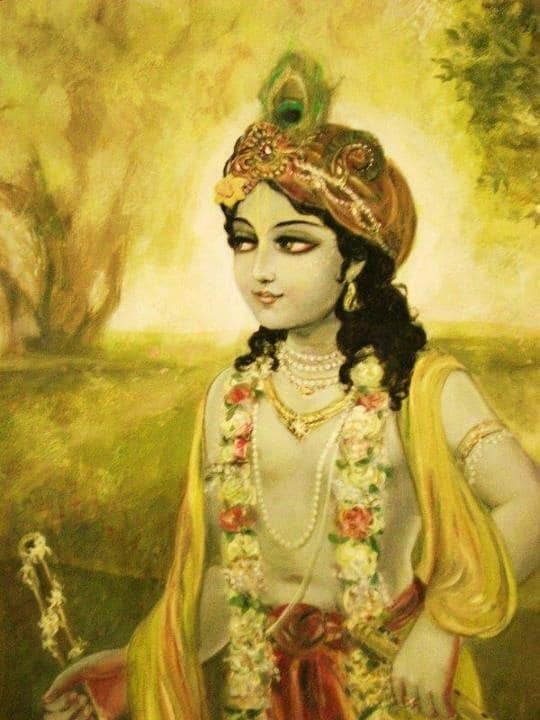



What is the destination of life?Srila Prabhupada ~ People do not know what is their destination of life. The destination of life is to reestablish his lost relationship with the Supreme Lord. That is his destination.Unfortunately, people do not know what is the destination. They are simply thinking, destination of life, to have the greatest amounts of sense gratification. This is illusion. Because we are materially absorbed, and materially concept of life means these senses—we have no other information—so we are trying to squeeze out all kinds of pleasure from sense. This is called illusion. They have no other information. They are earning, working very hard, and the ultimate goal is sense gratification. This is illusion.The ultimate goal is Kṛṣṇa, or the Supreme Lord, gati. Gati means destination. Where you are going? Which way you are making your progress? "Oh, that we cannot say. We make progress on sense gratification. The greatest amount of pleasure which we can derive out of the senses, that is our destination." No, the destination is God, Viṣṇu, the Supreme Lord, of whom we are the parts and parcels. By forgotting..., forgetting our relationship, we are struggling.mamaivāṁśo jīva-lokejīva-bhūtaḥ sanātanaḥmanaḥ ṣaṣṭhānīndriyāṇiprakṛti-sthāni karṣati[Bg 15.7][The living entities in this conditioned world are My eternal, fragmental parts. Due to conditioned life, they are struggling very hard with the six senses, which include the mind.]Prakṛti-sthāni, in this material nature, the fragmental portion of the Supreme Lord, living entities, the senses and the mind, entrapped by the senses, they are struggling. But this is not the destination. The Lord says, the Bhagavad-gītā says, that He is the destination. Na te viduḥ svārtha-gatiṁ hi viṣṇuṁ durāśayā, durāśayā ye bahir-artha-māninaḥ [SB 7.5.31]. Bahir-artha-māninaḥ means... This material nature is the external nature of the Supreme Lord.Because we have been entrapped in this material nature, therefore we are thinking that to make material advancement of life, that is the perfection. Durāśayā. This is called durāśayā. Durāśayā means... Duḥ means very distant, or duḥ means very difficult, and āśayā means hope. This hope is never to be fulfilled. This is a hope which will never be fulfilled. This is called illusion. We are making progress to make perfect life by this material advancement. This is our undue hope. It will never be fulfilled. Durāśayā, bahir-artha-māninaḥ.And what is the activity? Adānta-gobhir viśatāṁ tamisram. Adānta-gobhiḥ. Go means the senses. Adānta means unbridled, uncontrolled. Uncontrolled senses. Just like uncontrolled horse. You are on the carriage, and your horse is uncontrolled, unbridled, and he is taking you with full force and putting in the Atlantic Ocean. You cannot control. You see? So similarly, adānta-gobhir viśatāṁ tamisram. Viśatām means he is entering to the darkest part of ignorance by these uncontrolled, unbridled senses.So na te viduḥ svārtha-gatiṁ hi viṣṇuṁ durāśayā ye bahir-artha-māninaḥ [SB 7.5.31], adānta-gobhir viśatāṁ tamisraṁ punaḥ punaś carvita-carvaṇānām [SB 7.5.30].[Prahlāda Mahārāja replied: Because of their uncontrolled senses, persons too addicted to materialistic life make progress toward hellish conditions and repeatedly chew that which has already been chewed. Their inclinations toward Kṛṣṇa are never aroused, either by the instructions of others, by their own efforts, or by a combination of both.]These people who do not know the destination, they are trying to make experiment which is already experimented. From the Bhagavad-gītā we understand that our ultimate goal of life is to reach Kṛṣṇa, or the Supreme Lord. Gatiḥ. And bhartā. Bhartā means maintainer. Maintainer. He is maintaining everyone. That's a fact.Bhagavad-gītā 9.18–19Dec. 5, 1966, New York
#youtube#ISKCON#Hare Krishna#Krishna#Bhakti#Vedic#Vishnu#Vaishnava#Srila Prabhupada#Bhajan#Kirtan#Darshan#George Harrison#Krishna Consciousness#Radha Krishna
4 notes
·
View notes
Text
Indian Philosophy-Puruṣa and Prakṛti.प्रकृति को बिना जाने ,आप स्वयं को नहीं जान सकते।सांख्य दर्शन
Indian Philosophy-Puruṣa and Prakṛti.प्रकृति को बिना जाने ,आप स्वयं को नहीं जान सकते।सांख्य दर्शन
Indian Philosophy-Samkhya or Sankya is a dualistic orthodox school of Hindu philosohttps://www.youtube.com/watch?v=_uf33tJdMr4&t=134s&pp=ygUOc2Fuc2tyaXRrYXVkYXk%3Dphy. It views reality as composed of two independent principles, Puruṣa and Prakṛti.
प्रकृति को बिना जाने ,आप स्वयं को नहीं जान सकते।सा���ख्य दर्शन
Yogkiya

View On WordPress
0 notes
Text
When Jīva, attached to Prakṛti, realizes its own true nature...
“When Jīva, attached to Prakṛti,
realizes its own true nature with
clear understanding, all desires,
arising from the three Guṇa and
their variations cease entirely.
This state of Vairāgya,
free from all types of desire,
is called Para Vairāgya.”
– T Krishnamacharya on Yoga Sūtra Chapter One verse 16
– T Krishnamacharya Yoga Sūtra Study Quotes Collected and Collated
– TKV Desikachar Yoga Sūtra…
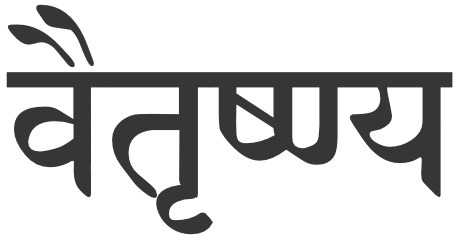
View On WordPress
0 notes